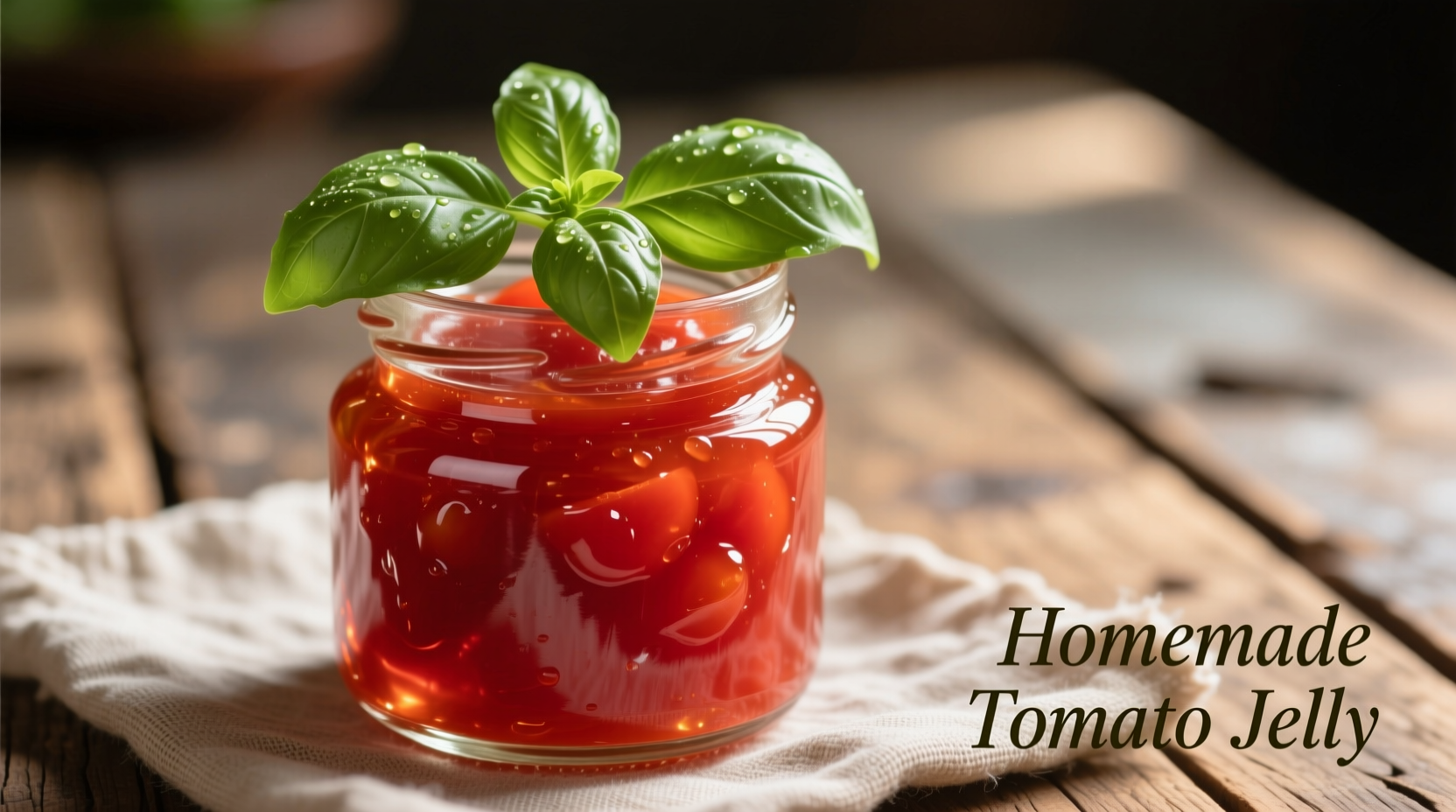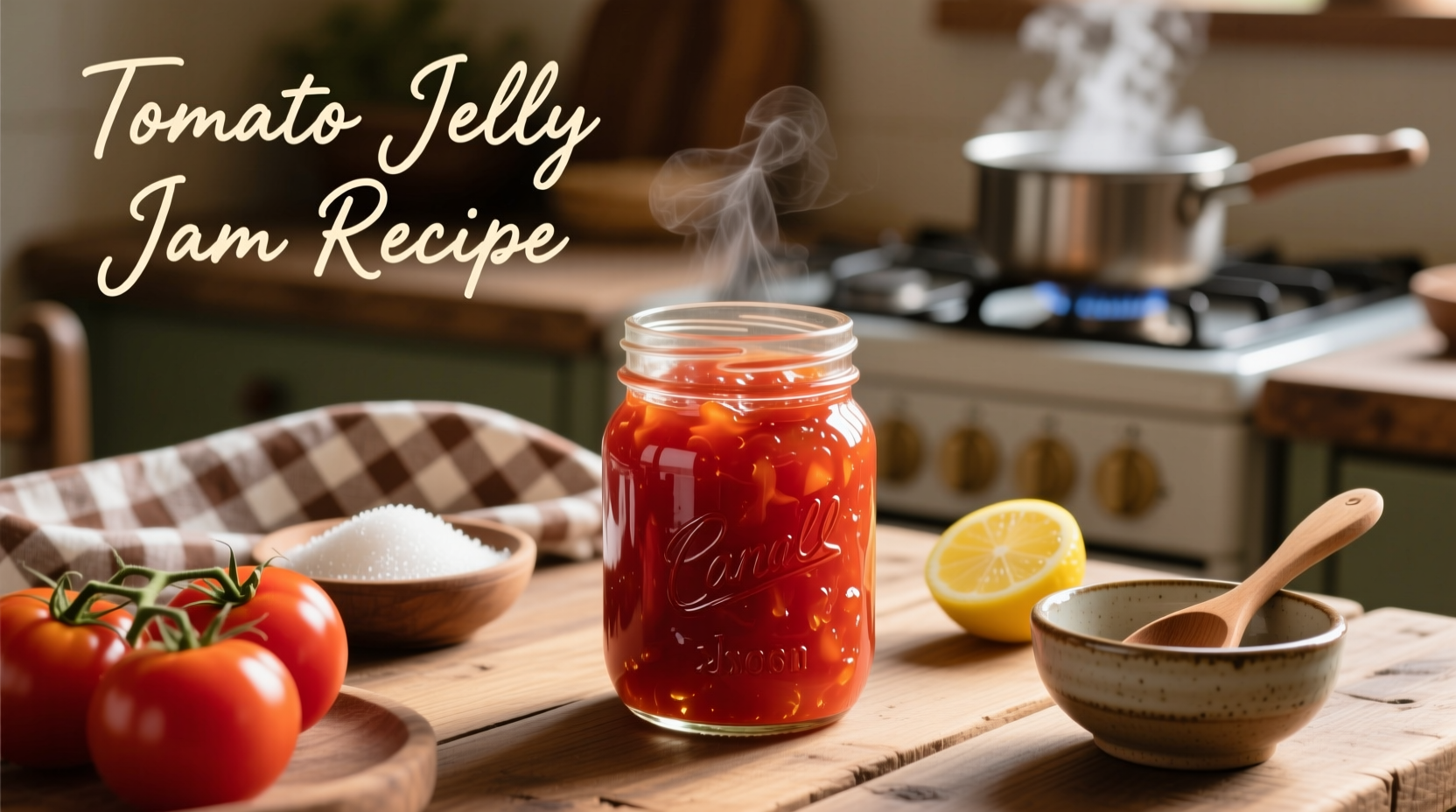Transform your garden tomatoes into a stunning, versatile preserve with this authentic tomato jelly recipe. You'll get crystal-clear, ruby-red jelly with a bright tomato flavor that sets perfectly—no pectin needed. This guide provides precise measurements, step-by-step canning instructions, and professional tips for achieving perfect texture every time.
Have you ever wondered what to do with surplus tomatoes beyond sauce and salsa? Tomato jelly offers a sophisticated solution that transforms ordinary tomatoes into an elegant preserve perfect for cheese boards, glazes, and unexpected culinary applications. As a French-trained chef specializing in European preserves, I've perfected this recipe through years of testing traditional methods with modern food science principles.
Why Tomato Jelly Deserves a Place in Your Pantry
Unlike tomato jam—which retains pulp and has a spreadable consistency—tomato jelly is clarified, resulting in a translucent, jewel-toned preserve with a clean tomato flavor. This distinction matters because:
| Preserve Type | Texture | Tomato Content | Best Uses |
|---|---|---|---|
| Tomato Jelly | Clear, firm set | Strained juice only | Cheese pairings, glazes, cocktails |
| Tomato Jam | Thick, spreadable | Whole fruit pulp | Sandwiches, toast, charcuterie |
| Tomato Sauce | Pourable liquid | Blended tomatoes | Pasta, stews, pizza base |
The Science Behind Perfect Tomato Jelly
Successful jelly formation depends on three critical factors: pectin, acid, and sugar. While tomatoes contain natural pectin, their levels vary significantly by variety and ripeness. The National Center for Home Food Preservation confirms that tomato pH must measure below 4.6 for safe water bath canning. This recipe includes lemon juice to ensure proper acidity while enhancing flavor.
Essential Equipment Checklist
- Fine mesh strainer or jelly bag (cheesecloth alone won't clarify properly)
- Candy thermometer (critical for testing gel point)
- 8-ounce canning jars with new lids
- Large stainless steel pot (avoid aluminum which reacts with acid)
- Muslin bag for spices (if adding variations)
Classic Tomato Jelly Recipe
Makes 4 half-pint jars | Total time: 3 hours (includes processing time)
Ingredients
- 4 pounds ripe tomatoes (Roma or plum varieties work best)
- 2 cups granulated sugar
- 1/4 cup bottled lemon juice (fresh varies in acidity)
- 1 teaspoon butter (reduces foaming)
- Optional: 1 cinnamon stick or 1/4 teaspoon red pepper flakes
Step-by-Step Preparation
1. Juice Extraction (60 minutes)
Chop tomatoes (no need to peel) and place in a large pot. Bring to a gentle simmer over medium heat, stirring occasionally until tomatoes break down (about 20 minutes). Transfer to a jelly bag or lined strainer set over a bowl. Allow to drip naturally for 1-2 hours—do not squeeze, as this clouds the jelly.
2. Testing for Natural Pectin (10 minutes)
Place 1 tablespoon cooked juice and 1 tablespoon rubbing alcohol in a small glass. If jelly-like strands form, sufficient pectin is present. If not, add 1 pouch liquid pectin later in cooking. Most ripe tomatoes contain adequate pectin when combined with lemon juice.

3. Cooking to Gel Point (25 minutes)
Combine tomato juice, sugar, lemon juice, and butter in a clean pot. Bring to a rolling boil over high heat, stirring constantly. Boil vigorously until mixture reaches 220°F (104°C) on a candy thermometer, or passes the plate test: chill a plate in freezer, drop a spoonful of jelly on cold plate—if it wrinkles when pushed, it's set.
4. Canning for Shelf Stability (10 minutes)
Immediately pour hot jelly into sterilized jars, leaving 1/4-inch headspace. Wipe rims, apply lids and bands. Process in a boiling water bath for 10 minutes (adjusting for altitude per USDA guidelines). Remove jars and cool undisturbed for 12-24 hours before checking seals.
Troubleshooting Common Issues
Cloudy jelly: Usually caused by squeezing the strainer or over-boiling. Next time, allow longer drip time and monitor temperature closely.
Too runny: Likely undercooked. Reboil with 1-2 tablespoons lemon juice to boost acidity and pectin activation.
Crystallization: Indicates sugar wasn't fully dissolved. Stir constantly during initial heating phase until sugar disappears.
Creative Serving Suggestions
- Pair with sharp cheddar or goat cheese on crostini
- Glaze for roasted meats (especially duck or pork)
- Swirl into cream cheese for bagel spread
- Thin with vinegar for vinaigrette base
- Mix with sparkling water for refreshing drink
Variation Ideas
Herbed Tomato Jelly: Add 2 sprigs fresh basil or thyme during cooking (remove before jarring)
Spiced Version: Include 1 cinnamon stick, 3 cloves, and 1 star anise in a muslin bag
Smoky Chipotle: Blend in 1-2 teaspoons chipotle powder during final boil
Storage Guidelines
Properly processed jars keep for 18 months in a cool, dark place. Once opened, refrigerate and use within 3 weeks. For longest shelf life, store jars away from direct light which degrades color and flavor over time.
Historical Context of Tomato Preserves
Tomato jelly emerged during Europe's preserve-making golden age (1880-1920) when home canning became widespread. Unlike today's focus on whole-fruit preserves, early 20th century cooks prized clear jellies as a demonstration of culinary skill. The USDA's first canning guide in 1917 included tomato jelly recipes, reflecting its popularity before commercial pectin made fruit jellies easier to produce.











 浙公网安备
33010002000092号
浙公网安备
33010002000092号 浙B2-20120091-4
浙B2-20120091-4